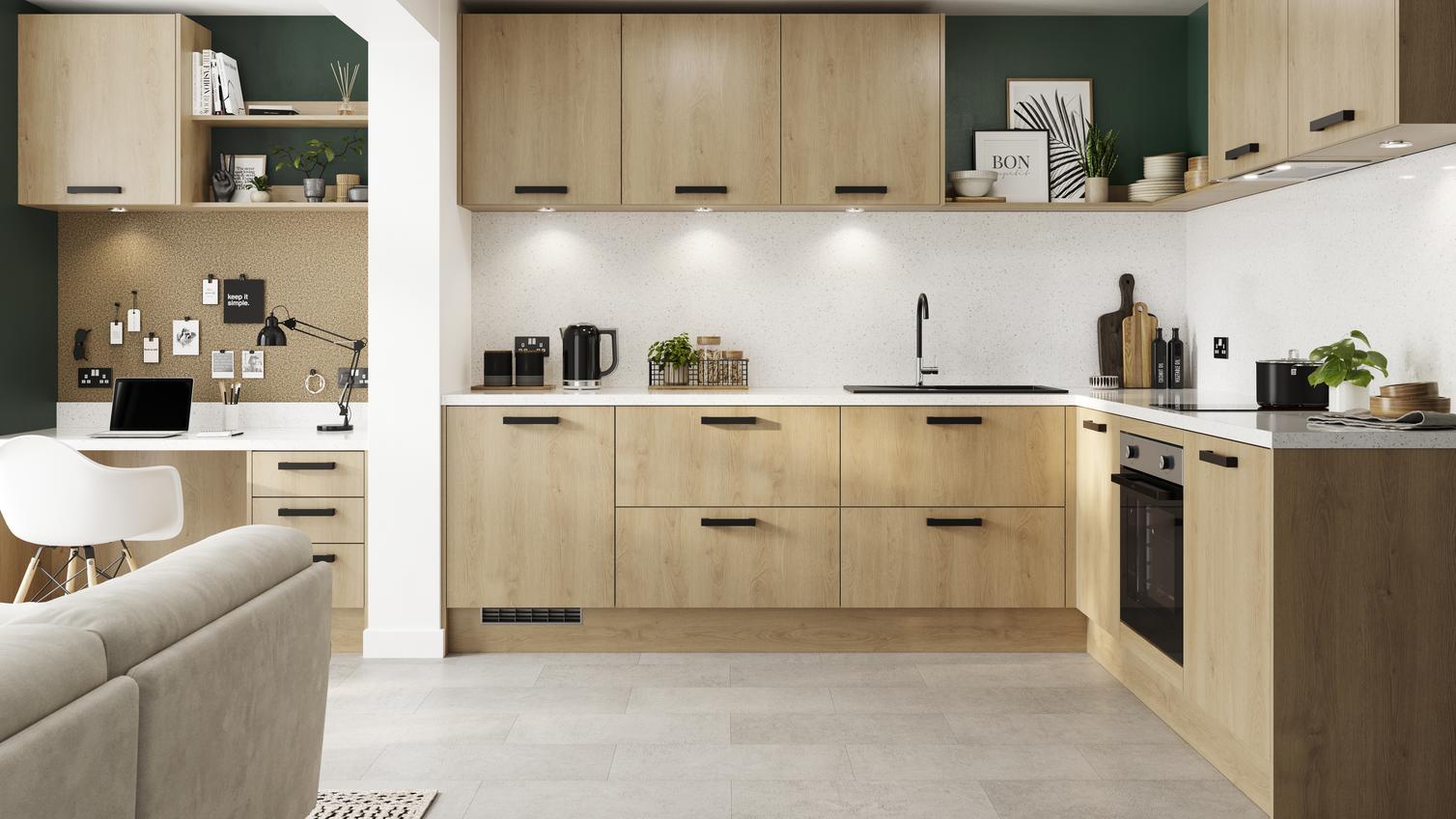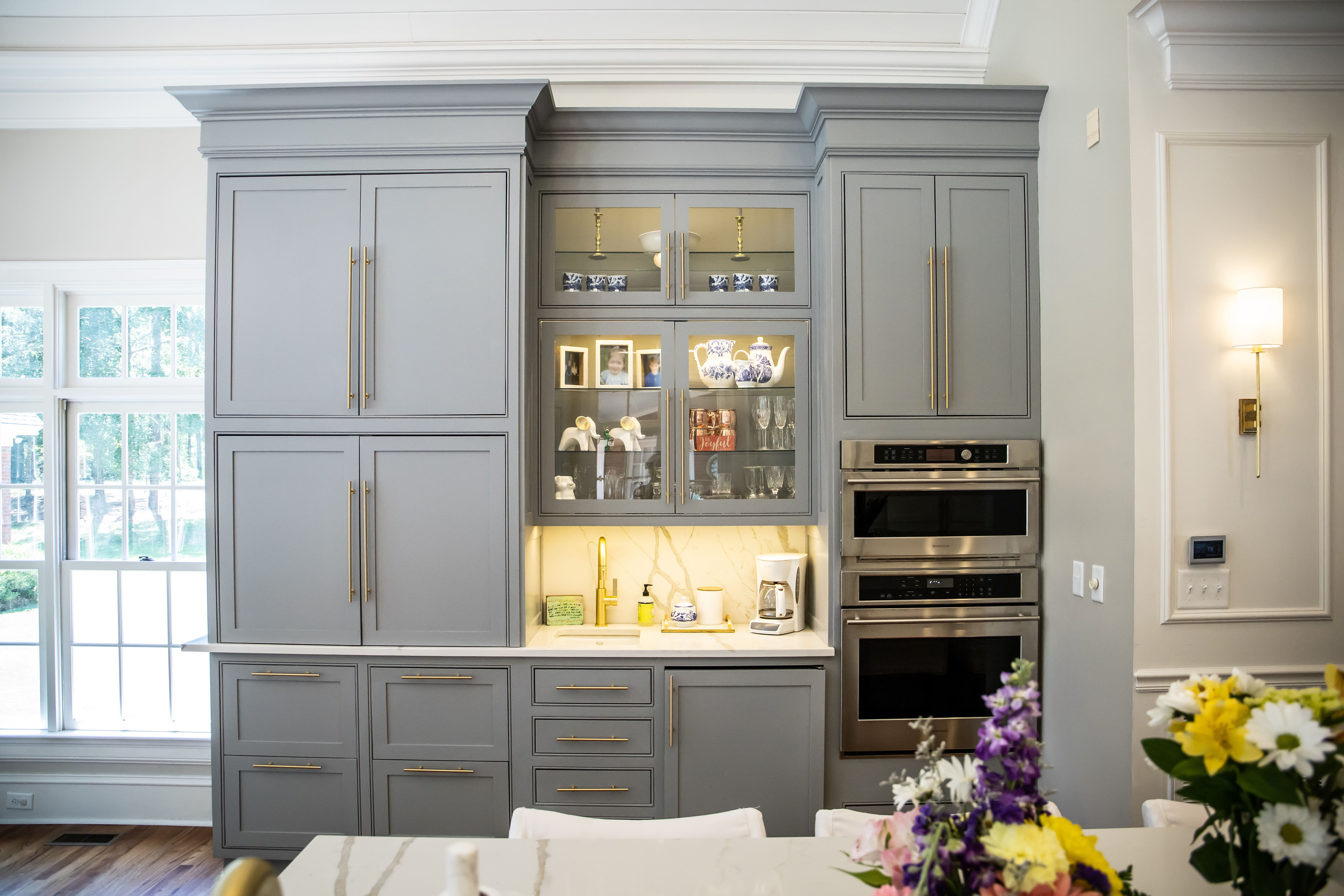Visual Appeal and Design of Limed Oak Kitchen Cabinet Doors

Limed oak kitchen cabinets offer a unique blend of rustic charm and modern sophistication. The subtle bleaching process creates a light, airy feel, while the natural grain still shines through, offering a warmth that painted cabinets often lack. This versatility makes limed oak a surprisingly adaptable choice for a wide range of kitchen styles.
Variations in Color and Grain Patterns of Limed Oak
The beauty of limed oak lies in its inherent variability. The liming process itself subtly alters the color, typically lightening the oak’s natural tones to a range of creamy whites, pale yellows, and even slightly grayed hues. The grain patterns remain visible, showcasing the wood’s natural texture – sometimes delicate and subtle, other times bolder and more pronounced, depending on the specific plank. Finishes further enhance these characteristics. A clear matte varnish will emphasize the natural color and grain, preserving a clean, minimalist aesthetic. A slightly tinted varnish can introduce warmer tones, such as honey or beige, while a whitewash effect can create a more dramatic, Scandinavian-inspired look. Finally, a distressed finish can add a layer of rustic charm, highlighting the texture and emphasizing the wood’s age.
Kitchen Layouts Featuring Limed Oak Cabinet Doors
The adaptability of limed oak allows it to seamlessly integrate into diverse kitchen designs.
Limed oak kitchen cabinet doors – Modern Kitchen: Imagine sleek, handleless limed oak cabinets paired with a crisp white quartz countertop. The clean lines of the cabinetry are complemented by a minimalist subway tile backsplash in a neutral tone, creating a bright and airy space. Stainless steel appliances complete the contemporary feel.
Traditional Kitchen: In a traditional setting, limed oak cabinets can be paired with a darker, richer countertop material like granite or marble, perhaps in a warm cream or beige tone. A patterned backsplash, maybe featuring decorative tiles or a natural stone mosaic, adds visual interest and complements the more ornate detailing often found in traditional designs. Brass hardware would further enhance this classic aesthetic.
Farmhouse Kitchen: For a farmhouse style, consider incorporating distressed limed oak cabinets with a butcher block countertop. The combination of the slightly weathered wood and the rustic countertop creates a warm, inviting atmosphere. A simple white or light-colored brick backsplash completes the look, echoing the rustic charm of the overall design. Black iron hardware adds a touch of contrast and industrial flair.
Visual Comparison with Other Popular Wood Choices
Limed oak offers a distinct visual impact compared to other popular wood choices. Cherry wood, known for its rich reddish-brown hues, presents a warmer, more traditional feel, often associated with classic elegance. Walnut, with its dark, sophisticated tones and striking grain patterns, projects a sense of luxury and modernity. Painted wood cabinets, on the other hand, offer limitless color possibilities and can be tailored to any design style, but lack the natural warmth and texture of wood. Limed oak provides a happy medium, offering the warmth of natural wood with the lightness and versatility to suit both modern and traditional aesthetics. While cherry and walnut offer richer color palettes, limed oak’s lightness makes smaller kitchens feel more spacious and bright. Painted wood’s versatility is a strength, but it sacrifices the inherent beauty of the wood grain.
Cost Comparison of Limed Oak Kitchen Cabinets
The cost of kitchen cabinets varies significantly depending on factors such as quality, sourcing, and the level of customization. However, a general comparison can be made to provide a reasonable estimate.
| Wood Type | Average Cost per Door | Pros | Cons |
|---|---|---|---|
| Limed Oak | $200 – $400 | Versatile, light and airy, durable | Can be more expensive than painted wood, requires specific finishing techniques |
| Cherry | $300 – $600 | Rich color, classic elegance, durable | More expensive than limed oak, can be darker than desired |
| Walnut | $400 – $800 | Luxurious appearance, striking grain, durable | Most expensive option, requires careful maintenance |
| Painted Wood | $150 – $300 | Affordable, wide range of color options, easy to maintain | Lacks the natural warmth and texture of wood |
Practical Considerations and Maintenance of Limed Oak Kitchen Cabinet Doors

Investing in limed oak kitchen cabinet doors is a decision that blends style and substance. Their inherent beauty promises years of enjoyment, but understanding the practical aspects of their care ensures that promise is fulfilled. Limed oak, while durable, requires mindful attention to maintain its charm and longevity in the demanding environment of a kitchen. Let’s explore how to best care for this beautiful wood.
Limed oak’s durability in a kitchen setting is largely dependent on the quality of the wood and the finish applied. The inherent hardness of oak provides a good base, resisting scratches and dents better than softer woods. However, the kitchen environment presents unique challenges. Fluctuations in temperature and humidity can cause the wood to expand and contract, potentially leading to cracking or warping over time. Direct exposure to water is especially detrimental, causing staining and potentially more serious damage. A high-quality finish, properly applied, significantly enhances the wood’s resistance to these factors. Regular maintenance plays a crucial role in extending the lifespan of your limed oak cabinets.
Cleaning and Maintaining Limed Oak Cabinet Doors
Regular cleaning is essential to prevent the buildup of grime and grease, which can dull the finish and attract damage. A gentle approach is key to preserving the beauty of the wood. Avoid harsh chemicals and abrasive cleaners that can strip the finish and damage the wood.
- Clean regularly with a soft, damp cloth. For stubborn marks, use a mild dish soap solution, ensuring to rinse thoroughly and dry immediately.
- Avoid using excessive water. Damp, not soaking wet, is the key.
- Polish occasionally with a furniture polish specifically designed for wood. This helps replenish moisture and protect the finish.
- Protect from direct sunlight. Prolonged exposure can cause fading and discoloration.
- Use coasters and placemats to prevent spills and scratches.
Repairing Minor Scratches and Dents, Limed oak kitchen cabinet doors
Minor scratches and dents are inevitable in a busy kitchen. Fortunately, many can be repaired with simple methods. The key is to act quickly before the damage becomes more extensive.
- For minor scratches: A touch-up pen or marker designed for limed oak can often effectively conceal minor scratches. Apply carefully, following the grain of the wood.
- For small dents: A damp cloth and gentle pressure can sometimes lift minor dents. If the dent persists, carefully use a wood filler that matches the limed oak’s color. Allow it to dry completely before sanding it smooth and applying a fresh coat of finish.
Preventing and Addressing Water Damage
Water is the biggest enemy of wood. Preventing water damage is far easier than repairing it. Immediate action is critical in case of spills.
Preventative measures include:
- Using a good quality sealant on the wood to protect it from moisture penetration.
- Installing a properly functioning exhaust fan above the stove to reduce moisture in the air.
- Wiping up spills immediately.
Addressing minor water damage:
- Blot up excess water immediately with a clean, absorbent cloth. Avoid rubbing.
- Allow the area to air dry completely.
- If a stain persists, carefully sand the area with fine-grit sandpaper, following the wood grain. Apply a fresh coat of finish to match the existing finish.
Styling and Coordinating Limed Oak Kitchen Cabinet Doors
Limed oak kitchen cabinets offer a unique blend of warmth and lightness, creating a versatile base for a multitude of kitchen styles. Their subtle grain and slightly bleached tone provide a canvas upon which you can build a truly personalized space, reflecting your unique taste and lifestyle. The key to unlocking their full potential lies in thoughtful styling and coordination.
Mood Boards: Exploring Complementary Styles and Color Palettes
The inherent versatility of limed oak allows it to seamlessly integrate into various design schemes. To illustrate this, consider three distinct mood boards, each showcasing a different aesthetic:
- Modern Minimalist: Imagine a crisp white kitchen, with sleek stainless steel appliances and minimalist countertops. The limed oak cabinets, with their clean lines, would act as a warm, natural counterpoint to the cool, modern elements. A palette of white, gray, and muted greens would enhance the airy feel, while pops of black in hardware or lighting fixtures would add a touch of sophistication. The overall effect is one of calm, understated elegance.
- Rustic Farmhouse: Here, the limed oak cabinets would be at home in a kitchen filled with natural textures and warm tones. Think exposed brick or stone, butcher block countertops, and woven textiles. A color palette of creamy whites, soft browns, and muted blues would complement the natural wood tones. The overall feeling is one of cozy, comfortable charm, reminiscent of a countryside cottage.
- Eclectic Bohemian: This style embraces a playful mix of patterns, textures, and colors. The limed oak cabinets provide a grounding element, anchoring the eclectic mix. Think vibrant patterned tiles, colorful cookware, and globally inspired accessories. A color palette featuring jewel tones, earthy browns, and pops of bright color would create a lively, energetic atmosphere. The overall aesthetic is one of vibrant, curated individuality.
Hardware Options: Enhancing the Look of Limed Oak Cabinets
Choosing the right hardware can significantly impact the overall look and feel of your kitchen. The following five options offer diverse styles and materials to complement limed oak:
- Sleek Brushed Nickel Pulls: These offer a modern, understated elegance, complementing the clean lines of the cabinets. The brushed nickel finish provides a subtle sheen without being overly flashy.
- Antique Brass Knobs: These add a touch of vintage charm, creating a warm and inviting atmosphere. The antique brass finish offers a rich, aged look that pairs well with the natural tones of the limed oak.
- Modern Black Handles: A bold contrast against the light oak, these handles create a striking visual impact. The matte black finish adds a touch of sophistication and modernity.
- Polished Chrome Knobs: These offer a classic, timeless look, reflecting light and adding brightness to the kitchen. The polished chrome finish provides a sleek, clean aesthetic.
- Natural Wood Knobs: For a cohesive and rustic feel, consider matching the cabinet wood with natural wood knobs. This creates a harmonious and organic look.
Incorporating Limed Oak Cabinets into Different Kitchen Design Schemes
The beauty of limed oak lies in its adaptability. Let’s explore how it can be integrated into three distinct kitchen styles:
- Minimalist Kitchen: In a minimalist kitchen, the light color of limed oak cabinets helps maintain a sense of spaciousness. Recessed lighting or strategically placed spotlights will highlight the cabinets’ clean lines and subtle grain. Avoid overly ornate lighting fixtures to maintain the minimalist aesthetic.
- Rustic Kitchen: In a rustic kitchen, limed oak cabinets can be paired with warm, ambient lighting, such as pendant lights or wall sconces with a warm, yellowish glow. This will enhance the natural wood tones and create a cozy atmosphere. Consider using dimmer switches to adjust the lighting according to the mood.
- Eclectic Kitchen: An eclectic kitchen can incorporate limed oak cabinets as a neutral backdrop for more vibrant elements. Use a mix of lighting styles, such as track lighting for task lighting and statement pendant lights over the island to add visual interest. The lighting can be used to highlight specific areas and create focal points.
